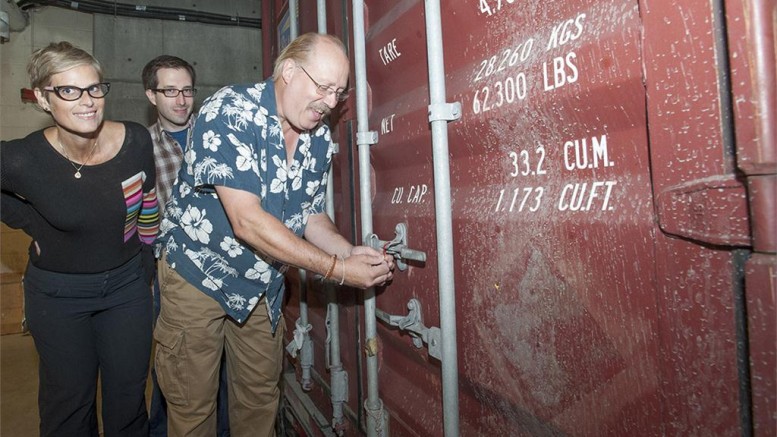It’s been six years since the first discussions about bringing geologist Douglas Kirwin’s renowned rock collection to the Royal Ontario Museum (ROM) in Toronto, and after a $3.7-million fundraising effort the vast collection has finally arrived from Thailand— but the work is far from over.
“It’s organized chaos at the moment,” says Katherine Dunnell, mineralogy and geology technician at the museum. She’s referring to the 21,000 pieces in 783 containers that are stacked and scattered throughout the museum’s mineralogy area in a third-level basement.
At 10 tonnes the Kirwin collection is truly massive. It’s comprised of 14,000 petrology specimens and 7,000 mineral specimens. “I don’t think we’ve ever received a collection this large at the museum,” Dunnell says.
It’s not just the size of the collection that makes it exceptional, but the quality of the rocks, which Kirwin amassed during his 40 years working as a geologist for mining companies such as Ivanhoe Mines, mostly in the Asia-Pacific region. Many of the rocks served as “puzzle pieces” that he used to make sense of deposits he worked on. But Dunnell describes Kirwin as having a “Darwin-esque fascination” with the natural world. As such, he often picked up things he simply found interesting.
Kirwin took great care of his collection, with many of the samples “cut and polished so you can see all the textures just brilliantly,” she says. “It’s just fantastic. It’s a dream.”
Dunnell shows off highlights from a small unpacked portion of the collection, while giving a preview to The Northern Miner. “I’m more of a gem girl,” she admits, picking up a grapefruit-sized red spinel, the largest of a handful of “perfect” specimens from Myanmar on informal display. These spinels lack iron and thus possess a unique body fluorescence.
She then points out one of the world’s rarest and most expensive minerals: painite. “Usually you have to put a little dot on the mineral to say ‘that’s where the painite is,’ because it’s usually tiny,” she says, holding up a strawberry-sized specimen.
Until March, most of the collection will remain packed in totes that are wrapped in plastic. In accordance with the museum’s pest control policy, the material must remain in this state for six months after arriving to neutralize any unwanted passengers that may have arrived with the collection.
Getting such a large collection to the museum was no easy task for ROM’s five-person mineralogy team, including Dunnell, who travelled to Kirwin’s compound in Bangkok last July to pack up all the material.
Loading tonnes of rock into boxes stacked to the ceiling of a sweltering shipping container was a chore — but that was just the half of it. “As part of the packing we needed to have a manifest for Canadian customs,” Dunnell says. That meant they had to log every single specimen on a spreadsheet. “We were working 13-hour days.”
As she worked her way through the collection, it was tough for Dunnell to refrain from fawning over the remarkable rocks, some of which she had only ever read about in textbooks. At times Kirwin, who she says has a photographic memory, would rush over and explain how he came to own various specimens.
In total it took the group 16 days to get the job done, with help from 10 local workers. The collection just about filled the shipping container. “Before we sealed it up there was a Buddhist monk that came to bless the shipment before it went off.”
After six weeks at sea the container arrived safely in Vancouver. From there it was trucked across the country to Toronto.
While the Kirwin collection boosts the breadth of the museum’s holdings, it also comes with a sorely needed upgrade to the ROM’s facilities. The museum has been using century-old wooden cabinets from the original geology gallery to store some of its material. “Wood is not good, it off-gasses acetic acid, which can actually be harmful for carbonates, sulphates and things like that.”
The $3.7 million raised will also pay for new storage facilities such a dry room and digital classroom, which will ensure the material is well preserved and accessible.
Dunnell says the Kirwin collection is “highly teachable” and that having it at the ROM will be a boon for students, who can come to the museum to examine and actually get their hands on the specimens. “We’re really one of the only tactile sciences,” she says, adding that Kirwin is especially keen on seeing his collection used to educate. “There will be a lot of projects for graduate and undergraduate kids at the University of Toronto. There are some really good masters projects in here.”
Firms in the mining industry have also expressed interest in what can be learned from the collection, with some planning to hold short courses at the museum.
The Kirwin collection will be part of the museum’s Earth & Space Centre of Discovery display, but staff are still deciding how to showcase it. “We could put a whole suite of ore material out, or we can put a bunch of flashy minerals. I think what we’ll end up doing is both,” Dunnell says. “You can go a lot of ways with this.”
It will be some time before the Kirwin collection is accessible. Upgrading the facilities and unpacking, cataloguing, photographing and digitizing the collection will take a while. Dunnell says it could be on display this year, but that’s being optimistic. However much longer it takes, it will surely be worth the wait.


Be the first to comment on "Kirwin collection arrives at the ROM"